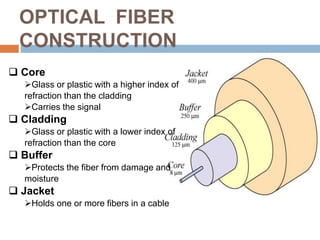Optical Fiber Cable V2
- 2. MADE BY - PRATYUSH EC – 42 (Roll No.-35) OPTICAL FIBER CABLE
- 3. CONTENTS ÔÇ® Brief Introduction ÔÇ® History ÔÇ® Optical fiber construction ÔÇ® Critical angle & Total Internal Reflection ÔÇ® Types of fibers/transmission modes ÔÇ® Acceptance angle & acceptance cone ÔÇ® Numerical Aperture ÔÇ® V-Number ÔÇ® Dispersion & its types ÔÇ® Attenuation and Losses in Fiber ÔÇ® Fiber optic communication ÔÇ® Fiber Vs Copper Cable ÔÇ® Fiber VS Co-axial Cable ÔÇ® Disadvantages ÔÇ® Applications ÔÇ® References
- 4. BRIEF INTRODUCTION ÔÇ® Optical fiber is flexible, transparent fiber made of silica or plastic slightly thicker than a human hair ÔÇ® It is a form of guided or wired non conducting medium ÔÇ® Its working is based on principle of Total Internal Reflection ÔÇ® It permits transmission over longer distances and at higher bandwidths than other forms of communication
- 5. HISTORY ÔÇ® In 1870, Tyndall introduced concept of Total Internal Reflection with a demonstration. ÔÇ® In the same year, Alexander Graham Bell, developed a optic voice transmission, which he named the photo phone.
- 6. HISTORY (contd.) ÔÇ® Later around 1954, Brien, Hopkins & Kapany achieved low loss transmission through 75 cm bundle of thousand fibers ÔÇ® Jun-ichi Nishizawa, was the first to propose the use of optical fibers for communications in 1963 ÔÇ® Kao and Hockham were first to reduce attenuation in optical fibers below 20 (dB/km), making it a practical communication medium which earned Kao the Nobel Prize in Physics in 2009.
- 7. OPTICAL FIBER CONSTRUCTION  Core Glass or plastic with a higher index of refraction than the cladding Carries the signal  Cladding Glass or plastic with a lower index of refraction than the core  Buffer Protects the fiber from damage and moisture  Jacket Holds one or more fibers in a cable
- 8. CRITICAL ANGLE & TOTAL INTERNAL REFLECTION ÔÇ® Critical angle is angle of incidence in denser medium for which angle of refraction in rarer medium is 90 degrees. ÔÇ® Total internal reflection-If angle of incidence in denser medium is increased beyond critical angle , then ray of light is reflected back completely into denser medium.
- 9. OPTICAL FIBER TRANSMISSION MODES/ TYPES OF FIBERS
- 10. TYPES OF FIBERS (contd.)  Multimode step-index fiber  the reflective walls of fiber move light pulses to receiver  Multimode graded-index fiber  acts to refract light toward center of fiber by variations in density  Single mode fiber  the light is guided down center of an extremely narrow core
- 11. TYPES OF FIBERS (contd.)
- 12. SINGLE MODE FIBER Advantages: ÔÇ® Minimum dispersion: all rays take same path, same time to travel down the cable. A pulse can be reproduced at the receiver very accurately. ÔÇ® Less attenuation, can run over longer distance without repeaters. ÔÇ® Larger bandwidth and higher information rate Disadvantages: ÔÇ® Difficult to couple light in and out of the tiny core ÔÇ® Highly directive light source (laser) is required ÔÇ® Interfacing modules are more expensive
- 13. MULTIMODE FIBER  Multimode step-index Fibers:  inexpensive  easy to couple light into Fiber  result in higher signal distortion  lower TX rate  Multimode graded-index Fiber:  intermediate between the other two types of Fibers
- 14. ACCEPTANCE ANGLE ÔÇ® Acceptance angle is maximum angle at which a light ray enters into core and propagate through it in zigzag path Acceptance angle
- 15. ACCEPTANCE CONE ÔÇ® If all possible direction of acceptance angle are considered at same time we get a cone corresponding to surface known as acceptance cone
- 16. NUMERICAL APERTURE ÔÇ® It defines gathering capability of fiber mathematically expressed as sine of acceptance angle ÔÇ® High Numerical Aperture increases dispersion hence low Numerical Aperture is desirable
- 17. V- NUMBER  No. of modes supported by optical fiber is obtained by cut-off condition known as normalized frequency or V-Number  Number of modes (N) = ½ V²  V- number can be reduced either by reducing numerical aperture or by reducing diameter of fiber
- 18. DISPERSION & ITS TYPES  Dispersion is the spreading out of a light pulse as it travels through the fiber  It is of two main types:  Intermodal or Modal Dispersion  Intra modal or Chromatic Dispersion
- 19. INTERMODAL OR MODAL DISPERSION  Spreading of a pulse because different modes (paths) through the fiber take different times  Only happens in multimode fiber  Reduced, but not eliminated, with graded-index fiber
- 20. INTRA MODAL OR CHROMATIC DISPESRSION  Different wavelengths travel at different speeds through the fiber  This spreads a pulse in an effect named chromatic dispersion  Chromatic dispersion occurs in both single mode and multimode fiber  It is of two types 1) Material Dispersion which is wavelength based effect caused by glass of which fiber is made 2) Waveguide Dispersion occurs due to change in speed of wave propagating through waveguide
- 21. ATTENUATION  Modern fiber material is very pure, but there is still some attenuation  The wavelengths used are chosen to avoid absorption bands -850 nm, 1300 nm, and 1550 nm -Plastic fiber uses 660 nm LEDs
- 22. LOSSES IN FIBER ÔÇ® Absorption Losses- due to material, impurities & atomic defects in glass fiber ÔÇ® Geometric Effects- due to manufacturing defects like irregular diameter of core ÔÇ® Rayleigh Scattering- ÔÉò Change in local refractive index due to local microscopic variation density ÔÉò It is a scattering loss
- 23. FIBER OPTIC COMMUNICATION Input Signal Coder or Converter Light Source Source-to-Fiber Interface Fiber-to-light Interface Light Detector Amplifier/Shaper Decoder Output Fiber-optic Cable Receiver TX, RX, and Fiber Link Transmitter
- 24. FIBER OPTIC COMMUNICATION (contd.)  Light source:  Amount of light emitted is proportional to the drive current  Two common types:  LED (Light Emitting Diode)  ILD (Injection Laser Diode)  Source–to-fiber-coupler (similar to a lens):  A mechanical interface to couple the light emitted by the source into the optical fiber  Light detector:  PIN (p-type-intrinsic-n-type)  APD (avalanche photo diode)  Both convert light energy into current. Note- For long links,repeaters are used to compensate for
- 25. FIBER VS COPPER CABLE  Smaller size & weight  Greater capacity  Faster communication  Transmit over Longer distances  Can be used for both analog & digital transmission  Broader Bandwidth – more data per second
- 26. FIBER VS COPPER CABLE (CONTD.)  Immunity to Electromagnetic Interference  Low attenuation/transmission loss over long distances  Electrical Insulator  Lack of costly metal conductor  Dielectric waveguide  Signal Security
- 27. FIBER VS CO-AXIAL CABLE ÔÇ® More information carrying capacity with higher data rates and fidelity ÔÇ® Greater transmission speed ÔÇ® Smaller in size and light in weight ÔÇ® Easier to handle and install ÔÇ® Immune towards environmental hazards & electromagnetic interference ÔÇ® Higher Bandwidth ÔÇ® Economical ÔÇ® Low signal loss
- 28. DISADVANTAGES ÔÇ® Cumulative losses due to large size of fiber couplers ÔÇ® Hazardous emissions like glass shards & optical radiation ÔÇ® Requires technicians with special expertise for installation & maintenance
- 29. APPLICATIONS ÔÇ® Used in Cable T.V. , HDTV, LANs & CCTV systems ÔÇ® Used in Optic Fiber Communication for transmission of analog & digital data ÔÇ® Used in Imaging Optics & Spectroscopy ÔÇ® Used in illumination applications ÔÇ® Used in various military applications ÔÇ® Fiber optic sensors & couplers
- 30. REFERENCES  Govind P. Agrawal, “Fiber Optic Communication Systems”, John Wiley, 3rd Edition,2004.  R J Hoss and EA Lacy, Fiber optics 2nd edition (Prentice Hall, New Jersey, 1993)  John M. Senior, “Optical Fiber Communications”, PEARSON, 3rd Edition, 2010.  Gerd Keiser, “Optical Fiber Communications”, TMH, 4th Edition, 2008.  Joseph C. Plais, “Fiber Optic Communication”, Pearson Education, 4th Ed, 2004.
- 31. THANK YOU































